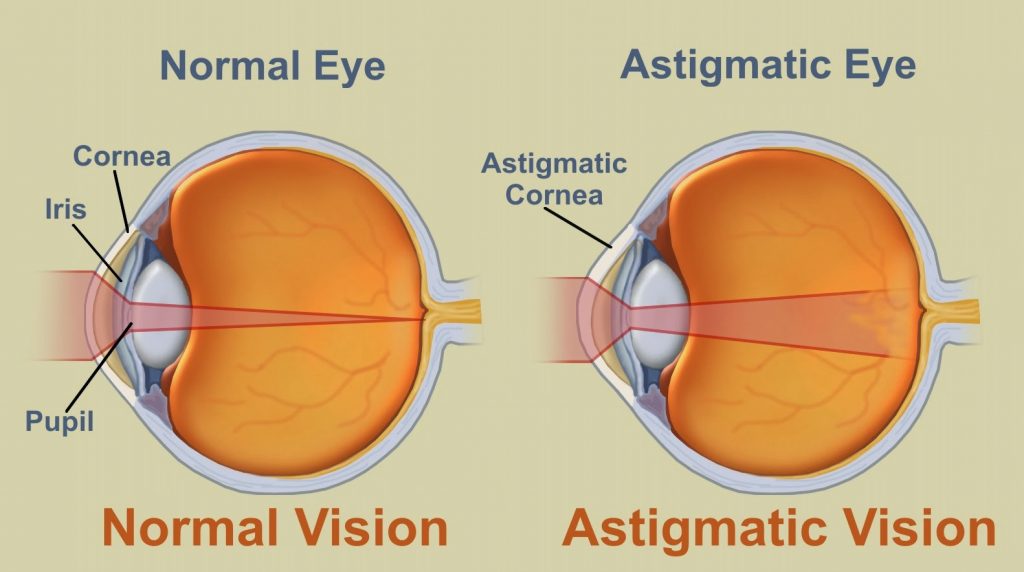
Understanding Astigmatism: Causes, Symptoms, and Treatment
Astigmatism is a common vision condition that affects how light enters the eye, causing blurred or distorted vision. It is a refractive error that occurs when the cornea or lens of the eye has an irregular shape. This irregularity prevents light rays from focusing properly on the retina, leading to visual disturbances. Astigmatism can occur alongside other refractive errors like nearsightedness (myopia) or farsightedness (hyperopia).
Causes and Types: Astigmatism occurs due to an irregular curvature of the cornea or lens, which results in different focal points for vertical and horizontal light rays. There are two main types of astigmatism:
- Corneal Astigmatism: This is the most common type of astigmatism and is caused by an uneven curvature of the cornea. Instead of being a perfect sphere, the cornea has different curvatures in different meridians. This leads to distorted or blurred vision at various distances.
- Lenticular Astigmatism: This type is caused by an irregular shape of the lens inside the eye. The lens should be uniformly curved, but in lenticular astigmatism, it has an uneven curvature, leading to visual problems.
Symptoms: The symptoms of astigmatism can vary in severity and may include:
- Blurred or distorted vision at all distances.
- Eye strain or discomfort, especially after prolonged periods of visual tasks.
- Headaches.
- Difficulty seeing clearly at night.
- Squinting to try and improve focus.
- Eye fatigue.
Diagnosis: Astigmatism is usually diagnosed during a comprehensive eye examination conducted by an optometrist or ophthalmologist. The exam includes various tests to assess your visual acuity and the shape of your cornea. The most common tests include:
- Visual Acuity Test: You’ll be asked to read letters from an eye chart to determine the sharpness of your vision.
- Keratometry: This measures the curvature of your cornea using a device called a keratometer.
- Corneal Topography: This advanced test maps the curvature of your cornea in detail.
- Refraction: Using a phoropter, the doctor will determine the prescription needed to correct your vision.
Treatment: Astigmatism can be effectively corrected through various methods, including:
- Eyeglasses: Prescription eyeglasses can correct astigmatism by compensating for the irregular shape of the cornea or lens. A cylindrical lens is often used to correct the difference in focusing power.
- Contact Lenses: Toric contact lenses are specially designed to correct astigmatism. They have different powers in different meridians of the lens and are adjusted to align with the irregular shape of the eye.
- Refractive Surgery: LASIK (Laser-Assisted in Situ Keratomileusis) and PRK (Photorefractive Keratectomy) are common refractive surgeries that can reshape the cornea to correct astigmatism. These procedures are considered for people who want a more permanent solution to their vision problems.
Prevention and Management: While astigmatism is primarily caused by genetic factors, maintaining good eye health can help prevent the progression or worsening of the condition. Regular eye exams are crucial to identify and address any vision problems early on. Additionally, following proper ergonomic practices while using electronic devices and taking breaks during prolonged reading or screen time can help reduce eye strain.
Astigmatism is a common vision problem that can affect people of all ages. While it may not be preventable, it is highly manageable through corrective lenses or refractive surgeries. If you experience any changes in your vision or discomfort, it’s important to consult an eye care professional for a thorough examination and appropriate guidance. With modern advancements in eye care, individuals with astigmatism can enjoy clear and comfortable vision.
ADVERTISEMENT
#astigmatism #eyecare #dryeyes #eyeinfection #contactlenses #eyeglasses #refractivesurgery #eyetest #blurredvision
Zena has just graduated in BA Hons Marketing Management at Cardiff Metropolitan University on the 17th July 2024, and plans on doing her Masters later this year.
Zena may look normal to an untrained eye even though she has an invisible disability. Thanks to a great support network she is able to fit into society and can get additional help, whenever she needs it.
Zena aspires to be a role model for young people with Multiple Sclerosis.
Zena works remotely which does not put a strain on her health. She writes articles and posts on an array of subjects, namely health and wellbeing, business, AI. She also does social media management, content creation and digital marketing.












Leave a Reply
You must be logged in to post a comment.